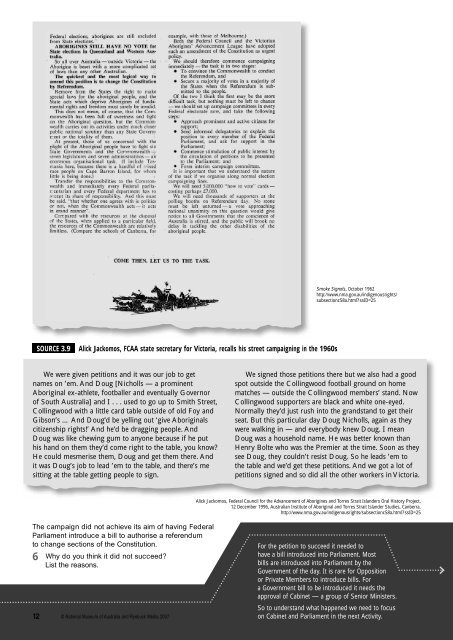The 1967 Referendum (PDF 1.4 MB) - National Museum of Australia
The 1967 Referendum (PDF 1.4 MB) - National Museum of Australia
The 1967 Referendum (PDF 1.4 MB) - National Museum of Australia
Create successful ePaper yourself
Turn your PDF publications into a flip-book with our unique Google optimized e-Paper software.
Smoke Signals, October 1962<br />
http://www.nma.gov.au/indigenousrights/<br />
subsectionc58a.html?ssID=25<br />
SOURCE 3.9<br />
Alick Jackomos, FCAA state secretary for Victoria, recalls his street campaigning in the 1960s<br />
We were given petitions and it was our job to get<br />
names on ’em. And Doug [Nicholls — a prominent<br />
Aboriginal ex-athlete, footballer and eventually Governor<br />
<strong>of</strong> South <strong>Australia</strong>] and I . . . used to go up to Smith Street,<br />
Collingwood with a little card table outside <strong>of</strong> old Foy and<br />
Gibson’s … And Doug’d be yelling out ‘give Aboriginals<br />
citizenship rights!’ And he’d be dragging people. And<br />
Doug was like chewing gum to anyone because if he put<br />
his hand on them they’d come right to the table, you know?<br />
He could mesmerise them, Doug and get them there. And<br />
it was Doug’s job to lead ’em to the table, and there’s me<br />
sitting at the table getting people to sign.<br />
We signed those petitions there but we also had a good<br />
spot outside the Collingwood football ground on home<br />
matches — outside the Collingwood members’ stand. Now<br />
Collingwood supporters are black and white one-eyed.<br />
Normally they’d just rush into the grandstand to get their<br />
seat. But this particular day Doug Nicholls, again as they<br />
were walking in — and everybody knew Doug. I mean<br />
Doug was a household name. He was better known than<br />
Henry Bolte who was the Premier at the time. Soon as they<br />
see Doug, they couldn’t resist Doug. So he leads ’em to<br />
the table and we’d get these petitions. And we got a lot <strong>of</strong><br />
petitions signed and so did all the other workers in Victoria.<br />
Alick Jackomos, Federal Council for the Advancement <strong>of</strong> Aborigines and Torres Strait Islanders Oral History Project,<br />
12 December 1996, <strong>Australia</strong>n Institute <strong>of</strong> Aboriginal and Torres Strait Islander Studies, Canberra.<br />
http://www.nma.gov.au/indigenousrights/subsectionc58a.html?ssID=25<br />
<strong>The</strong> campaign did not achieve its aim <strong>of</strong> having Federal<br />
Parliament introduce a bill to authorise a referendum<br />
to change sections <strong>of</strong> the Constitution.<br />
6 Why do you think it did not succeed?<br />
List the reasons.<br />
12<br />
© <strong>National</strong> <strong>Museum</strong> <strong>of</strong> <strong>Australia</strong> and Ryebuck Media 2007<br />
For the petition to succeed it needed to<br />
have a bill introduced into Parliament. Most<br />
bills are introduced into Parliament by the<br />
Government <strong>of</strong> the day. It is rare for Opposition<br />
or Private Members to introduce bills. For<br />
a Government bill to be introduced it needs the<br />
approval <strong>of</strong> Cabinet — a group <strong>of</strong> Senior Ministers.<br />
So to understand what happened we need to focus<br />
on Cabinet and Parliament in the next Activity.

















